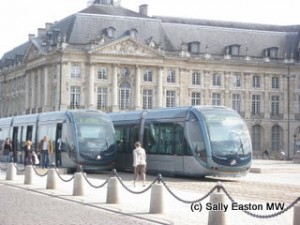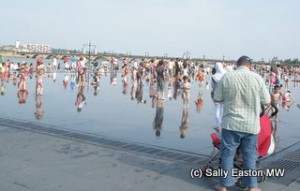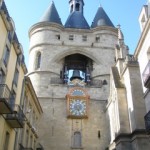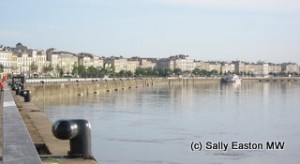Bordeaux wine tourism, part 1 – the city
Bordeaux city, not much to do with wine you may think, but in the last decade the city has undergone such a volte face, such a resurrection, that if I had not been in it before and after, I would struggle to believe quite how dramatically the city has improved. It is now a pleasure to visit, making it a desirable hub for wine forays. It is also well worthy of a short break holiday in itself, if anyone were ever to take holidays that didn’t involve visiting wine producers.
But if you are visiting wine producers, and haven’t booked anything before arriving, the tourism office is your port of call. From May to October, you can book onto an off-the-rack wine tour, from several choices on both left and right banks. Prices vary from €45 for half a day to €90 for a full day’s trip. For example, an all-inclusive day in the commune of Margaux promises you’ll learn about the 1855 classification at Château Prieuré-Lichine, the terroir at Rauzan-Gassies, the grape varieties and how to blend them at La Tour de Bessan, and winemaking and the trade at Château Kirwan.
The tourism office is also the point of booking for other visit programmes organised privately by some of the châteaux, such as where a group of four women winemakers of Crus Bourgeois châteaux, monikered Les Médocaines, (more in depth article to be posted soon) offer blending workshops led by one of the owners. The half day session needs to be booked at the tourism office, and transport is included.
The transport thing is a consideration, because the vineyards, both left and right banks, are up to an hour’s drive and more from Bordeaux city.

Trams at the Bourse
If you do have your own transport though, the arrival of the tram in 2003 inside the city has made it more difficult to bring a car into the city centre. But this is becoming a fairly normal feature of urbanism in the 21st century. For the visitor the benefits outweigh the inconvenience. The inner city has a modest population of about a quarter of a million, which makes walking the ideal form of transport. A day-ticket for the tram is the only accompaniment required.
The tram was contentious when first mooted, and caused massive upheaval, but the ultra-sleek, shiny, slate-grey trams glide effortlessly around the city along three lines. And in the historic centre, the city was the first in Europe to introduce power from a third rail, which has meant there are no overhead wires and pillars to obstruct views of the monumental facades. The tram stops at the main railway, but doesn’t quite reach Merignac airport, 10km from the city, and this is an obvious shortcoming.
While the tram was being built, the city’s facades have been cleaned, giving a spruce appearance to what used to be grimily blackened buildings. The patina of age may be attractive in antique furniture, but on buildings it can have an overbearing, depressing effect on visitors’ and inhabitants’ perceptions.
On the riverfront, the classical 18th century Place de la Bourse is quite the centre-piece. But the restoration stretches much further – there are now 4.5km of newly-restored riverfront. Along the Quai de Chartrons, the old quarter of wine negociants, the warehouses fronting the old harbour have been removed and a promenade created, with gardens where walkers, bicyclists, skateboarders, roller-bladers all get by together, without a hint of painted lanes on the surface to keep everyone separate. A few of the old harbour warehouses remain, as a reminder of a previous era in the city’s past, but these have been converted to a skate park, a restaurant, and shops.

Miroir d'eau
A central part of the redevelopment, right in front of the Bourse, is the miroir d’eau, which has become an inspirational, yet deceptively simple focal point. A large rectangle of very shallow water attracts folk of all ages for a cooling paddle in a couple of centimetres of water. Small fountains sporadically spurt a fine enveloping mist a metre or so skywards to offer more fun for people to run through. At night the water is calm and unruffled, giving a perfect reflection of the Place de la Bourse buildings, which can be lit up to accentuate the reflective event. The night view can best be seen from the right bank of the river, and the restaurant L’Estaquade, built on stilts out in the river Garonne opposite the Place de la Bourse is the place to watch the sun go down and the lights come up on Bordeaux’s most famous skyline.
Behind the 18th façade lies the medieval heart of the old city. It is mostly pedestrian-only access, indeed the rue Ste. Catherine is the longest pedestrian street in Europe, with continuous shopping opportunities.

Grosse Cloche
The tourism office runs guided walking tours in English and French of old Bordeaux at 10am almost every day. It’s easy to lose an entire weekend admiring the listed architecture, from the 12th to 15th century Grosse Cloche bell tower at the southern end of the ancient city, and the gothic Cailhau gate down towards the Pont de Pierre, to the entire 4.5km of the riverfront centred on the Place de la Bourse. Much of the view of the old town can be taken in from atop the tower adjacent to the Saint Michel Basilica.
For those with a winey bent the Wine and Trade museum (Musée du vin et du Négoce) on the Quai des Chartrons, the historic home of the wine business since the middle ages, shows how the Bordeaux wine trade was conducted from this previously marshy area of river frontage. From April to October, Monday to Sunday, from 10am to 6pm, €7 buys a visit, including a taste of two wines.

Quai des Chartrons
Undoubtedly as a result of much of the renovation and re-vitalisation of the city, Bordeaux became a Unesco World Heritage site in 2007. June of that year saw nearly half the city area of Bordeaux listed, an area encompassing the Port of the Moon – around the Bourse and Quai de Chartrons – so called because of the crescent moon shape formed by the historic part of the left bank as the river makes a hardish-right turn on its way towards the estuary.
Additionally, as part of the city’s changing attitude, ten years ago it also became part of a new tourism group – the Great Wine Capitals of the world, a group of eight ‘wine capitals’ spanning the new and old worlds that, among other things, presents ‘best of wine tourism’ awards for excellence in various touristic categories such as service to customers, innovation and degrees of sustainability.
The other capitals are Bilbao for Rioja, Cape Town, Firenze/Florence, Mainz in the Rheinshessen, Mendoza, Porto and San Francisco for the Napa Valley.
No oenophilic visit to Bordeaux city would be complete without a stint at the Ecole du Vin at the Maison du Vin. The Maison du Vin is bang in the middle of town, opposite the tourism office, and just down from the Grand Theatre. It is also the headquarters of the CIVB, (The Bordeaux Wine Bureau, an organisation of industry members, producers, brokers, negociants.)
There are plenty of courses running at the school. To dip a toe in the water, €25 buys a two-hour introduction to the Bordeaux region and its wines. And for the serious amateur, €350 gets a two-day course on soil, grapes, classifications, appellations and tasting technique; and €600 buys a three day course on the grands crus, including visiting classed growth properties, left bank and right bank.
To relax after the day’s study, or if the classroom and fieldwork is too much, the Maison du Vin has a modern wine bar, open from 11am to 10pm on Monday to Saturday, where a rotating selection of Bordeaux wines can be tasted, many for €3 to €4 for a 15cl glass, with various plates of cheese and charcuterie also on offer.
This article was inspired by a visit to the region in May 2009 sponsored by the CIVB.



